Unit 4 Body language Warming up and reading课件(30张PPT)
文档属性
| 名称 | Unit 4 Body language Warming up and reading课件(30张PPT) |  | |
| 格式 | zip | ||
| 文件大小 | 1.5MB | ||
| 资源类型 | 教案 | ||
| 版本资源 | 人教版(新课程标准) | ||
| 科目 | 英语 | ||
| 更新时间 | 2019-11-16 22:39:49 | ||
图片预览

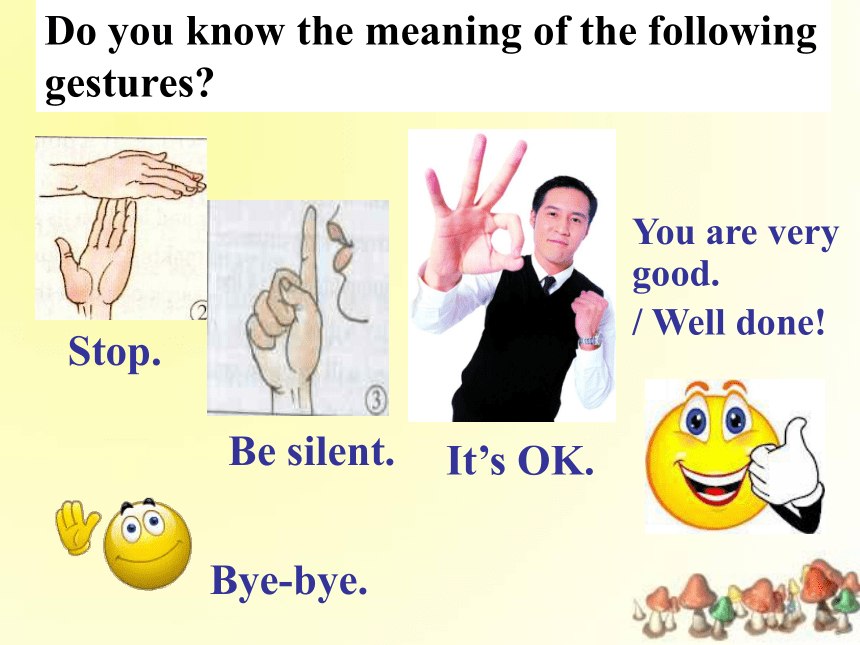
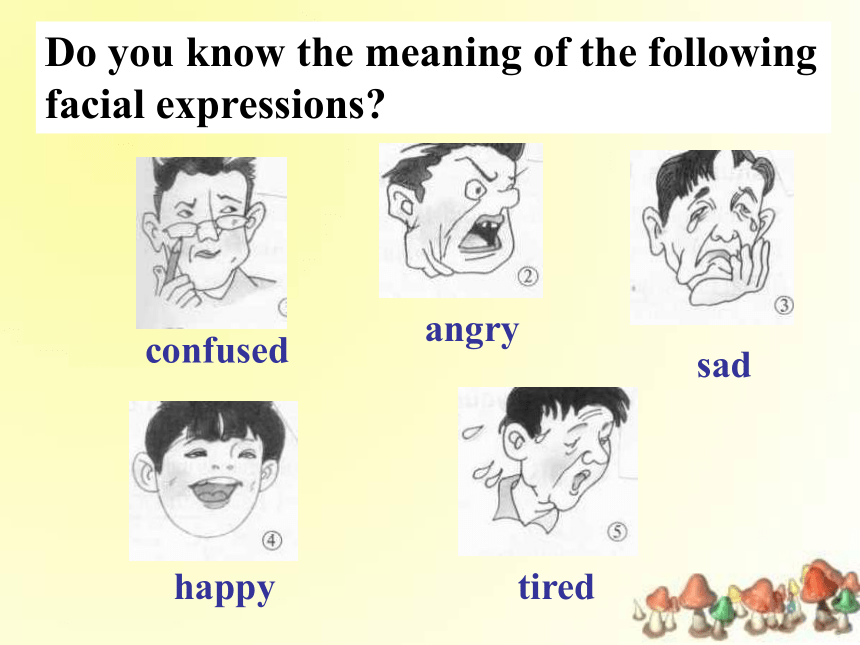
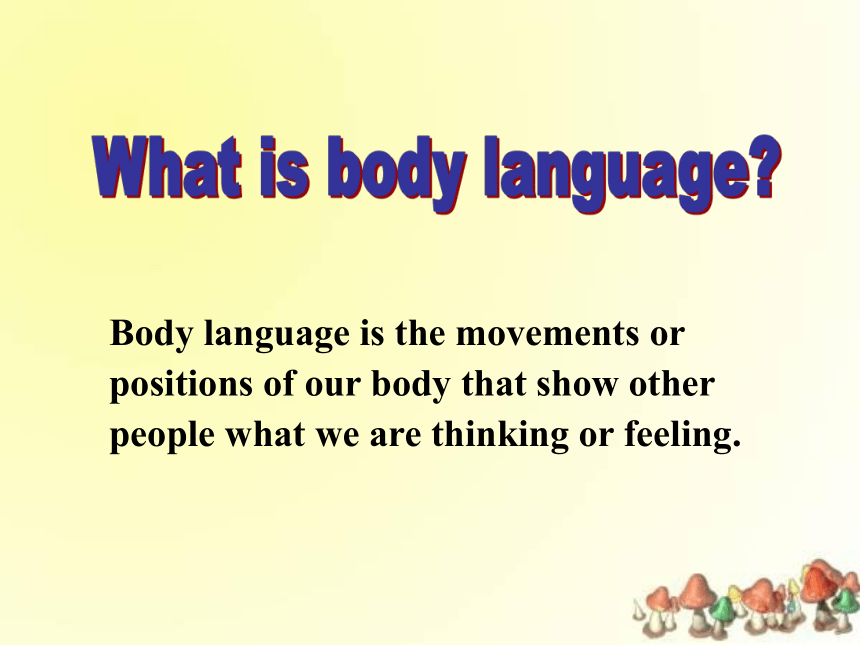
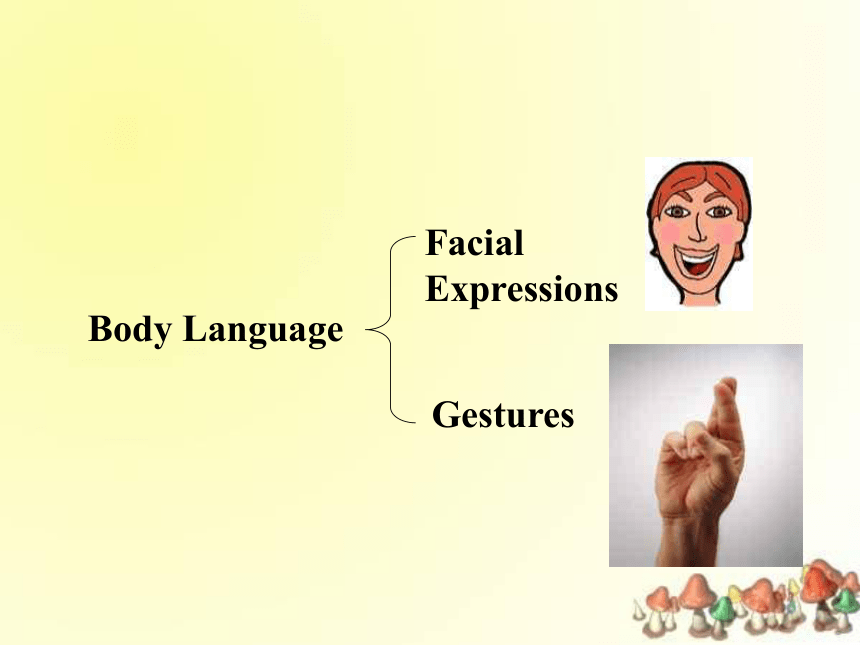
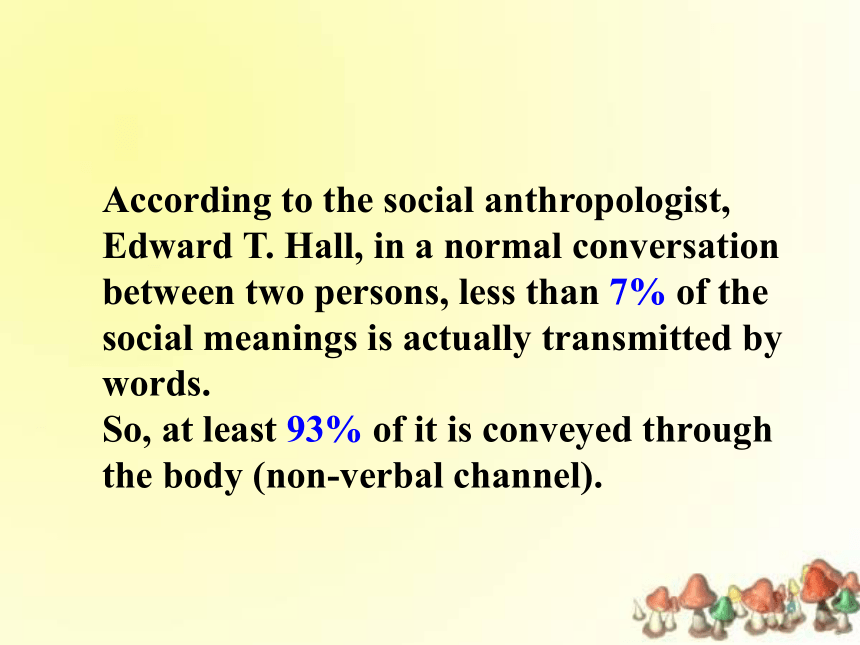


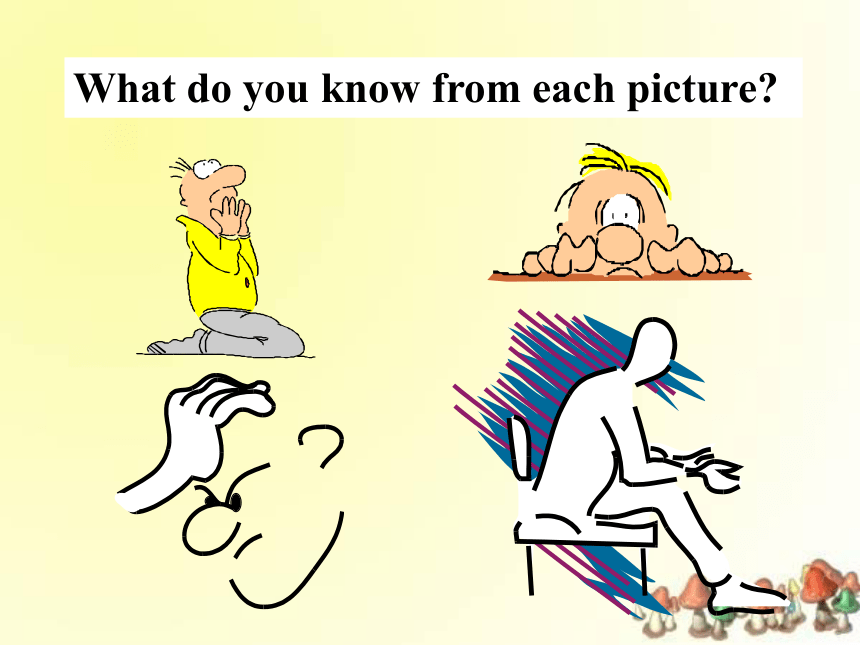

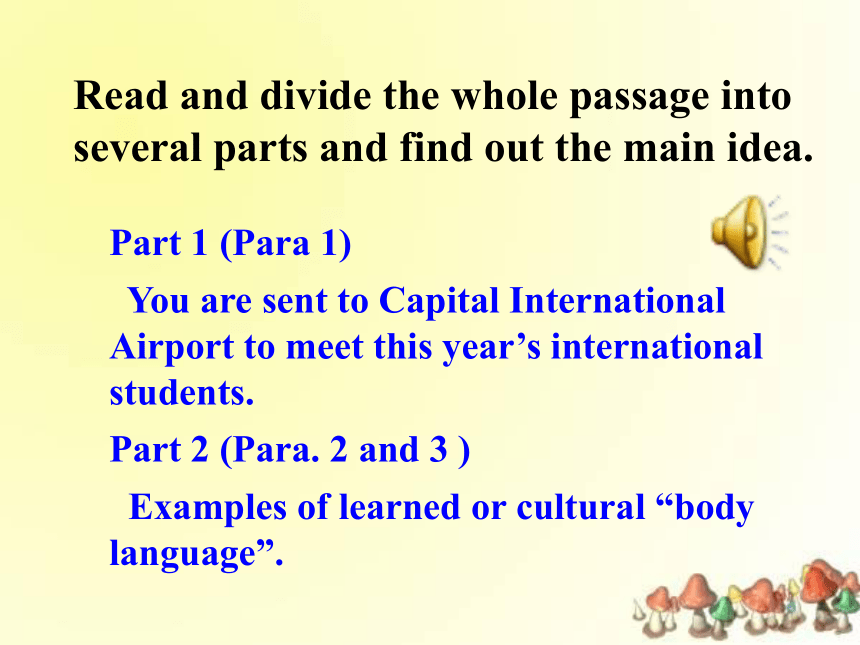
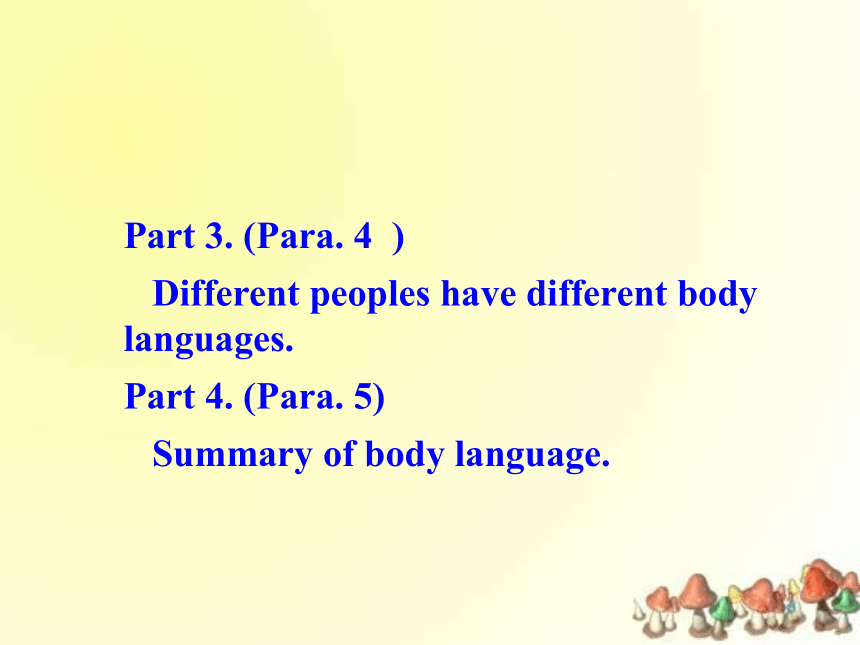
文档简介
(共30张PPT)
Unit 4
Warming up and reading
Body language
Stop.
Be silent.
You are very good.
/ Well done!
It’s OK.
Bye-bye.
Do you know the meaning of the following
gestures?
Do you know the meaning of the following
facial expressions?
confused
angry
sad
happy
tired
Body language is the movements or positions of our body that show other people what we are thinking or feeling.
Body Language
Facial Expressions
Gestures
According to the social anthropologist, Edward T. Hall, in a normal conversation between two persons, less than 7% of the social meanings is actually transmitted by words.
So, at least 93% of it is conveyed through the body (non-verbal channel).
How can you use body language to communicate the following ideas?
I am having a headache!
I am strong!
I don’t know.
Victory!
Success!
Go away!
Please keep quiet!
It is very hot today!
Good luck for you!
Sorry, I can’t hear you.
What do you know from each picture?
1. Do you think body languages are all the same throughout the world? Give an example.
2. Do you think people from different countries express the same meaning with different body languages?
Read and divide the whole passage into several parts and find out the main idea.
Part 1 (Para 1)
You are sent to Capital International Airport to meet this year’s international students.
Part 2 (Para. 2 and 3 )
Examples of learned or cultural “body language”.
Part 3. (Para. 4? )
?? Different peoples have different body languages.
Part 4. (Para. 5)?
Summary of body language.
Read carefully and decide if the following statements are true (T) or false (F).
Englishmen often stand close to others or
touch strangers as soon as they meet.
2. Most people around the world now greet each other by kissing.
3. Japanese will bow to others as greeting.
F
F
T
4. People from Jordan will move very close
to you as you introduce yourself to them.
5. Some body languages in some countries
are good while some countries’ body
language are bad.
T
F
Answer the questions.
Is the author of this passage male or female? How do you know?
The author is male. Ahmed Aziz will not shake hands with women, but he shakes hands with the author.
2. What were the two mistakes that the author noticed?
He noticed that the Colombian man kissed the British woman, but in her culture, a kiss from a stranger is not acceptable. He also noticed that the Japanese man bowed just as the Canadian man started to shake hands, so one man’s nose touched the other man’s hand.
3. Who seemed to prefer to keep more physical distance from others? Who seemed to prefer closer physical distance?
The British woman, Julia, and probably the Canadian man, George, seemed to prefer to keep more physical distance from others. The Colombian man, Tony, and the Jordanian man, Ahmed, seemed to prefer closer physical distance.
4. Did any students have similar greeting customs? If so, which ones?
Yes. Tony from Colombia and Darlene from France had a similar greeting custom --- a kiss. George from Canada and Ahmed from Jordan also had a similar greeting custom --- a handshake, but Ahmed shakes hands only with men.
5. “When in Rome, do as the Romans do.” What do you think this famous saying means?
This saying means that when we are in a certain place, we should follow the customs of the people who live in that place, not our own customs.
What can you learn from this passage?
Body language is very important in our daily life, and it may vary from different cultures. When we are visiting other countries, we should follow their customs. That is to say when in Rome do as the Romans do.
Tips for handshaking
When to shake hands?
1. come across some acquaintance
2. see our customers off
??? 3. say good bye to our customers
?? ?4. when we introduce our friends
??? 5. come across our boss or colleague
? ? 6. give thanks to people who offer support or help
??? 7. congratulations on friends
8. when you agree with other people
??? 9. when you comfort some one who is in hardship
10. when receiving gifts
Gesture
Lady: hold the index figure
Man: hold the full palm
The principles of shaking
The strength of shaking
* Never too heavily or too lightly.
Never shake hands absent-mindedly or with left hand.
The time of shaking
Attentions
Taboo 1
Taboo 2
Taboo 3
Never shake hands with gloves or hats.
Unit 4
Warming up and reading
Body language
Stop.
Be silent.
You are very good.
/ Well done!
It’s OK.
Bye-bye.
Do you know the meaning of the following
gestures?
Do you know the meaning of the following
facial expressions?
confused
angry
sad
happy
tired
Body language is the movements or positions of our body that show other people what we are thinking or feeling.
Body Language
Facial Expressions
Gestures
According to the social anthropologist, Edward T. Hall, in a normal conversation between two persons, less than 7% of the social meanings is actually transmitted by words.
So, at least 93% of it is conveyed through the body (non-verbal channel).
How can you use body language to communicate the following ideas?
I am having a headache!
I am strong!
I don’t know.
Victory!
Success!
Go away!
Please keep quiet!
It is very hot today!
Good luck for you!
Sorry, I can’t hear you.
What do you know from each picture?
1. Do you think body languages are all the same throughout the world? Give an example.
2. Do you think people from different countries express the same meaning with different body languages?
Read and divide the whole passage into several parts and find out the main idea.
Part 1 (Para 1)
You are sent to Capital International Airport to meet this year’s international students.
Part 2 (Para. 2 and 3 )
Examples of learned or cultural “body language”.
Part 3. (Para. 4? )
?? Different peoples have different body languages.
Part 4. (Para. 5)?
Summary of body language.
Read carefully and decide if the following statements are true (T) or false (F).
Englishmen often stand close to others or
touch strangers as soon as they meet.
2. Most people around the world now greet each other by kissing.
3. Japanese will bow to others as greeting.
F
F
T
4. People from Jordan will move very close
to you as you introduce yourself to them.
5. Some body languages in some countries
are good while some countries’ body
language are bad.
T
F
Answer the questions.
Is the author of this passage male or female? How do you know?
The author is male. Ahmed Aziz will not shake hands with women, but he shakes hands with the author.
2. What were the two mistakes that the author noticed?
He noticed that the Colombian man kissed the British woman, but in her culture, a kiss from a stranger is not acceptable. He also noticed that the Japanese man bowed just as the Canadian man started to shake hands, so one man’s nose touched the other man’s hand.
3. Who seemed to prefer to keep more physical distance from others? Who seemed to prefer closer physical distance?
The British woman, Julia, and probably the Canadian man, George, seemed to prefer to keep more physical distance from others. The Colombian man, Tony, and the Jordanian man, Ahmed, seemed to prefer closer physical distance.
4. Did any students have similar greeting customs? If so, which ones?
Yes. Tony from Colombia and Darlene from France had a similar greeting custom --- a kiss. George from Canada and Ahmed from Jordan also had a similar greeting custom --- a handshake, but Ahmed shakes hands only with men.
5. “When in Rome, do as the Romans do.” What do you think this famous saying means?
This saying means that when we are in a certain place, we should follow the customs of the people who live in that place, not our own customs.
What can you learn from this passage?
Body language is very important in our daily life, and it may vary from different cultures. When we are visiting other countries, we should follow their customs. That is to say when in Rome do as the Romans do.
Tips for handshaking
When to shake hands?
1. come across some acquaintance
2. see our customers off
??? 3. say good bye to our customers
?? ?4. when we introduce our friends
??? 5. come across our boss or colleague
? ? 6. give thanks to people who offer support or help
??? 7. congratulations on friends
8. when you agree with other people
??? 9. when you comfort some one who is in hardship
10. when receiving gifts
Gesture
Lady: hold the index figure
Man: hold the full palm
The principles of shaking
The strength of shaking
* Never too heavily or too lightly.
Never shake hands absent-mindedly or with left hand.
The time of shaking
Attentions
Taboo 1
Taboo 2
Taboo 3
Never shake hands with gloves or hats.
同课章节目录
